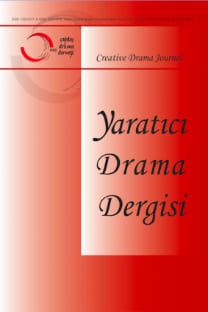Dansın Çocuk ve Gençlerle Kurduğu İletişimin Niteliği: Estetik Mesafe, Özdeşleşme ve Estetik Deneyim
Her sanat dalı kendine has nitelikleriyle seyircisine diğer sanat dallarından farklı bir estetik deneyim vaat eder. Bu çalışmanın asıl amacı da dans sanatının özgül niteliklerinden yola çıkarak çocuk ve genç seyircisine vaat ettiği estetik deneyimin niteliklerini keşfetmektir. Dansa ve harekete ilişkin 2000'lerde artan disiplinlerarası özellikle sinirbilimi, psikoloji ve sosyolojiyi içine alan deneysel çalışmaların da gösterdiği gibi dans sadece doğrudan imgeleme seslenme yoluyla değil, aynı zamanda kinestetik yolla da iletişim kurarak başka hiçbir sanat formunun sağlayamayacağı özel bir biçimde çocuk ve gençlerin estetik deneyim yaşamasını sağlar. Bu çalışmada da son 10 yılda yapılan bu deneysel çalışmaların bulguları ve dans teorisyenlerinin görüşleri derlenerek üç temel soruya cevap aranır. İlk olarak "dansın bu kendine has iletişimsel yönünün çocuklar ve gençler için ne tür bir estetik deneyime dönüşeceği" sorusu gündeme gelir. Buradan hareketle çocuk ve gençler için estetik deneyimi oluşturan iki temel kavram ortaya çıkar: estetik mesafe ve özdeşleşme. Çalışmanın ilk bölümü olan Dans, Estetik Mesafe ve Özdeşleşme bölümünde bu temel kavramlar dans sanatının estetik doğası da dikkate alınarak çocuk ve gençler için yeniden tanımlanır ve dans yoluyla sağlanan estetik deneyimin özgün niteliği ortaya çıkarılır. İkinci bölüm olan "Dans Yoluyla Kurulan Kinestetik İletişim"de ise “Neden dans ediyoruz ya da dans izlemekten bu kadar keyif alıyoruz?" sorularının cevabı aranarak çocuk ve gençler için dans sanatının iletişimsel gücü ortaya konulur. Üçüncü olarak da dansı diğer hareket biçimlerinden ayıran noktaların ne olduğu üzerinde durulur ve buradan hareketle dansın teatral etkinliklerde çocuk ve gençler için taşıdığı potansiyel araştırılır. Sonuç olarak dünyayı kavrayışımızda, algılayışımızda en çok ihmal edilen hatta son yıllara kadar unutulan kinestezi duyumuzun dans yoluyla çocukluktan itibaren yeniden canlandırılabileceği ve teatral etkinliklerde sağladığı olanaklar vurgulanır.
The Quality of Relationship Between Dance and Children and Youth: Aesthetic Distance, Identification and Aesthetic Experience
Each field of art commit a different type of aesthetic experience to own audience from others by its own idiosyncracy. The main porpuse of this research is to discover these idiosyncracy aesthtetic experince of dance which was committed to their children and youth audiences. As it’s shown by experimental interdisciplinary researchs about dance and movement which involve neuroscience, psychology and sociology in 2000’s, dance not only connect with our immagination but also enable children and youth to get aesthetic experience in a idiosyncratic way through kinesthetic communication. In this paper I focused on three main questions as compiling the results of researchs and arguments of dance theoretician in last 10 years. First of these questions is “what is the role of dance played by its idiosyncratic ways of kinesthetic communication in children and youth’s aesthetic experience?” Accordingly, two essential concepts are generated which composed the aesthetic experience for children and youth: aesthetic distance and identification. These essential concepts are re-described for children and youth as considering characteristics of them in the first chapter, Dance, Aesthetic Distance and Identification. And the idiosyncratic ways of communication of dance in the relationship between dance and children is unfold. Second chapter Kinesthetic Communication through Dance is try to answer the questions of “why we are dancing?” or “how and why we like watching dance?” and produce the communication ability of dance for children and youth. Finally, it’s dwelled on which charactheristcs distinguish dance from other movement styles and based on this it’s emphasised that potantial of dance in theatre for young audience. As a result in this paper it is emphasized that we can ensoul our kinesthetic sense which is ignored especially in recent years as from our childhood. Thus the importance of the possibilities of dance in creative drama and in theatre for young audience is exhibited.
